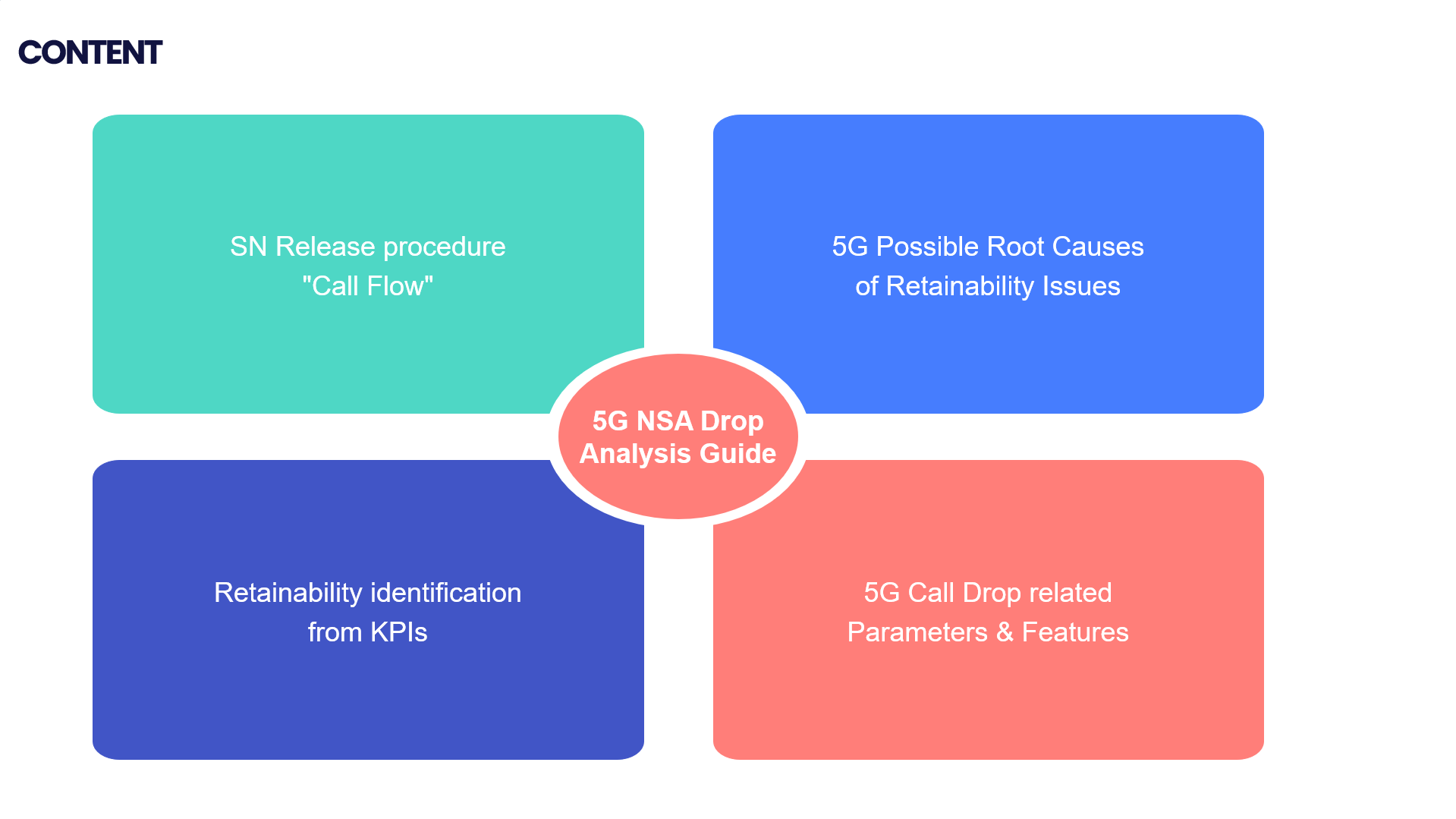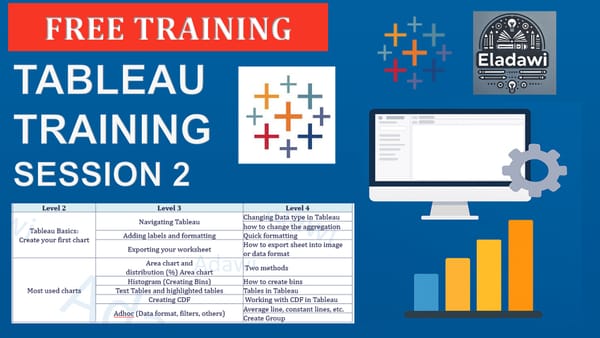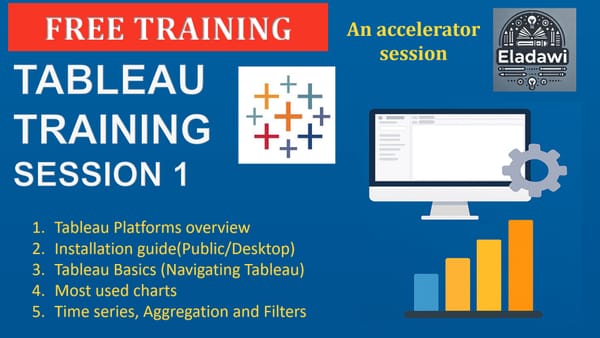5G NSA Retainability: Signaling Insights and Troubleshooting Guide (With Video)

Introduction:
This Article is a deep dive into 5G NSA Retainability Signaling overview and Call Drop Failures Possible Causes & Troubleshooting Methods.
The following topics are explored in this article:
- SN Normal Release procedure "Call Flow"
- Breakdown of the Normal Release Causes
- SN Release procedure - Abnormal Release " Call Flow" --> Exactly same as Normal Release
- 5G Possible Root Causes of Retainability Issues
- Retainability identification from KPIs
- 5G Call Drop related Parameters & Features
(1) SN Release procedure "Call Flow"
SN Release procedure - Normal Release
- The Normal release can be initiated by the Master Node “MN” or Secondary Node “SN” as will be discussed in this article.
- The Following is the most common causes for the Normal Release messages

The following steps and figure shows an example signaling flow for the MN & SN initiated Secondary Node Release procedure:
- When the release is initiated by the Mater Node(MN), the Master Node(MN) initiates the procedure by sending the SgNB Release Request message. If the release is initiated by Secondary Node(SN), the Secondary Node(SN) initiates the procedure by sending the SgNB Release Required message.
- for MN initiated release, the SN confirms SN Release by sending the SgNB Release Request Acknowledge message. For SN initiated release, the Master Node(MN) confirm the SN release by sending SN release confirm
- If required, the MN indicates in the RRCConnectionReconfiguration message towards the UE.
- The UE will respond with an RRC Reconfiguration Complete message if it can successfully decode all the information in the RRC Reconfiguration message.
- If the released bearers(RB) use RLC AM, the SN sends the SN Status transfer.
- Data forwarding from the SN to the MN takes place.
- This means that the remaining data will be transferred to the 4G leg after the 5G leg is released."
- The SN sends the Secondary RAT Data Volume Report message to the MN and includes the data volumes delivered to the UE over the NR radio for the related E-RABs.
8. If applicable, the path update procedure is initiated.
9. Upon reception of the UE Context Release message, the SN can release radio and control plane related resource associated to the UE context. Any ongoing data forwarding may continue.


(2) Breakdown of the Normal Release Causes
Now, let's explain the most common causes of the normal release mentioned above:
- Normal Release Cause: due to MCG or SCG Mobility:
- SCG Mobility (Triggered by SN) is initiated incase if there a secondary node change being triggered.

- Below is an example for the , after the MN Initiated sgNB addition request to a new SN (Target-SN) and once the request is acknowledged by the Target-SN, the MN initiates an SgNB release request with the cause of MCG Mobility, which is categorized under the normal release. this is usually happened if there is a handover triggered by the 4G Side(i.e 4G A3 Handover), especially in the scenarios the handover being triggered from 4G Anchor layer to 4G Non-Anchor Layer.


Below is the 3GPP TS 38.423 definition for both MN & SN Mobility release causes:

- Normal Release Cause: due to Action-Desirable for Radio Network:
- Sometimes, this message might be interpreted as a drop or abnormal release. However, in fact, it is a normal release mainly caused by the NR NSA User being at critical coverage, which is reaching the A2 Threshold for Secondary cell removal, as shown in the figure below.
- When the signal quality of the Primary Serving Cell (PSCell) consistently diminishes and there is no suitable neighboring cell identified for a PSCell handover, the decision to delete the PSCell can be triggered by event A2.

Below is the 3GPP TS 38.423 definition for Action Desirable for Radio Reasons cause:

- Normal Release Cause: due to to SgNB User inactivity timer:
- The SgNB release due to inactivity timer can be triggered by MN or SN based on the network parameters when the SgNB is in the inactive state:

Below is the 3GPP TS 38.423 definition for User Inactivity cause:

(3) SN Release procedure - Abnormal Release " Call Flow"
- The detection of NR Radio Link Failure (RLF) can be carried out by either the UE(MN) or the gNodeB (SN).
- A 5G Call Drop (RLF) is identified and declared through various factors, including transmission issues, core problems, 5G Downlink (DL) and Uplink (UL) radio frequency (RF) issues, UE capability issues, 4G RF issues (RRC Reestablishment), and lastly, configuration issues.
- Most of the possible drop causes will be explained in the next section.

- The following figures shows an example signaling flow for the MN & SN initiated Secondary Node Abnormal Release procedure:
- In Case of Master Node “ MN “ initiated the release due to abnormal cause the UE will first report a SCG Failure information to the MN which can be one of the following causes:
- Random Access Problems during Access or Handovers (Unlike 4G, RA Issues are counted as a drop in 5G NSA)
- Maximum number of UL RLC retransmissions in is reached: Mostly caused by UL Interference or Poor UL Coverage/Quality
- T310Expiry: Mostly caused by Coverage & Quality Issues
- SynRecgfail: The UE fails to search for cells (synchronization failure, failure to receive SSB)
- RecfgFail: this is mostly caused by Configuration or UE Issues

- In Case of Seconday Node “ SN “ initiated the release due to abnormal cause the SN will initiate SgNB Release required with radio network cause: Radio-Connection_with-UE-Lost and this is usually due to two possible causes:
- UE is in the uplink out-of-synchronization state due to UL related timers
- Maximum number of DL RLC retransmissions in is reached due to DL Coverage (BLER and Poor DL Radio Condition)

(4) 5G Possible Root Causes of Retainability Issues
- The detection of NR Radio Link Failure (RLF) can be carried out by either the UE(MN) or the gNodeB (SN).
- A 5G Call Drop (RLF) is identified and declared through various factors, including and not limited to the following:
- 4G RF issues (RRC Reestablishment)
- Core problems.
- Transmission issues
- 5G MAX DL RLC retransmission reached
- Random access problem
- 5G MAX UL RLC retransmission reached
- T310Expiry
- UE capability issues
- Configuration issues.
Now, let's go through the most possible causes of the 5G NSA abnormal release mentioned above:
(A) 4G RF issues (RRC Reestablishment)
- This is mainly RF issues in the 4G Leg. For example RRC Reestablishment failure.

(B) Core Related
- As shown in the figure below, after the SgNB Addition was completed, the eNodeB (MN) initiated an e-RAB Modification indication to the MME to change the traffic path from SGW to MN to SGW to SN.
- During the path switch exchange, there might be scenarios where the MME does not reply to the E-RAB Modification indication, and this will be counted as a 5G NSA Drop.

(C) Transmission Fault
- This might be caused by an X2 interface fault during transmission over X2-U.
- For example, in the scenario assumed below, there was an X2 Link fault during the SN change procedures, which might lead to a drop.

(D) 5G MAX DL RLC retransmission reached
- As shown in the figure below, once the maximum number of DL RLC Retransmissions reaches the configured threshold, the gNB (SN) will initiate an SgNB Release Required message, which causes radio-connection-with-UE-Lost.

(E) Random Access Problems
- In 5G NSA, RACH procedures towards the 5G Leg start after the SgNB addition procedure is completed.
- Accordingly, any failures in the RA Process will lead to a 5G NSA Drop.
- As shown in the figure below, once the RA Process fails, the UE initiates an SCG Failure information with the cause randomAccessProblem to the eNodeB (MN).
- Then, the MN initiates an SgNB Release request due to RAProblem to the SN.

(F) MAX UL RLC retransmission reached
- During 5G NSA UL Data transfer, the UE might face a UL Interference or Poor UL Coverage/Quality which might lead into problems in UL Packets delivery.
- As shown in the figure below, once the maximum number of UL RLC Retransmissions reaches the configured threshold, the UE reported a SCG Failure information with cause rlc-MaxNumRetx then the e-NB (SN) will initiate an SgNB Release request message, which includes the same cause.

(G) T310Expiry
- UE will report SCG Failure information with cause When Radio Link Failure is detected is detected due to T310 expires, for example assume that the current DL BLER is 11% or more for the UE.
- In this scenario, if the Out-Of-Sync indications reach the n310 value, the T310 timer starts, giving the UE a chance to sync back.
- If the UE doesn't hit the BLER-In target within the set thresholds during the T310 timer, the RLF Layer steps in.
- When the T310 Timer runs out without success, the UE declares a radio link failure.
- In the picture below, once the UE declares RLF and T310 Timer expires, the T311 timer begins. It waits for the UE to kick off RRC Connection Reestablishment.
- If the UE didn’t recover the connection before T310 Expiry, a drop occurs.


(5) Retainability identification from KPIs
- As shown below, from the drop-related counters, you can identify the top drop signatures.

(6) 5G Call Drop related Parameters and Features
The figure below summarizes the parameters/features where you can tune to improve the 5G NSA Drop rate.

YouTube video for the same
References:
- 3GPP TS 37.340 version 15.5.0 Release 15
- 3GPP TS 38.423 version 16.2.0 Release 16
- Practical experience




